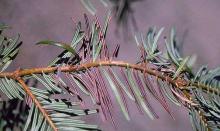Cause Two fungi, Lirula abietis-concoloris and Virgella robusta, occur infrequently on white, grand, noble, Pacific silver, and California red fir. These fungi have a 2-year life cycle. Newly emerged needles are infected but persist through the first and second growing seasons. During the third growing season, fruiting bodies and spores are produced.
Symptoms Infections may remain symptomless until early in the second growing season, when needles turn brown or tan. Both fungi form long, dark brown sexual fruiting bodies (apothecia) on the undersides of needles. They can be differentiated from each other by the arrangement of asexual fruiting bodies (pycnidia) on the needles' upper surfaces. V. robusta forms two rows of light brown pycnidia on the needle margins. L. abietis-concoloris forms a single brown line of pycnidia down the center of the needle. After spores are shed, needles fall off. Repeated infection and defoliation leaves the tree with only two needle complements.
Cultural control
- Avoid planting in low-lying areas with poor air drainage.
- Space plants for good air circulation.
- Control weeds around the bases of trees.
Reference Scharpf, R.F. 1988. Epidemiology of Lirula abietis-concoloris on white fir in California. Plant Disease 72:855-858.



